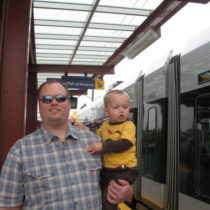Landscape Architecture for Landscape Architects › Forums › GENERAL DISCUSSION › Landscape Design & Solar Panels
- This topic has 1 reply, 7 voices, and was last updated 14 years, 5 months ago by
 david maynes.
david maynes.
-
AuthorPosts
-
March 25, 2011 at 9:29 pm #163977
 Mark WarrinerParticipant
Mark WarrinerParticipantHas anyone thought of how to fit solar panels into a landscape design?
March 27, 2011 at 1:10 pm #163985 david maynesParticipant
david maynesParticipantI recall Topos 2010 ‘Sustainability’ had a piece about a waterfront project that used solar panels as a sort of paver (the units were customized to be walked on, etc). I wish I could remember the project and where, but anyhow the general point being using photovoltaics as a hardscape.
July 19, 2011 at 10:45 am #163984Peter Livings
ParticipantHi,
This is something I am looking to write my dissertation on. I have only just started researching the topic but I have seen a few examples that could be relevant.
I saw the project in Topos too which really sparked my interest. It’s called ‘greeting to the sun’ and is in Zadar, Croatia.
http://www.croatia.org/crown/articles/9541/1/Spectacular-Monument-to-The-Sun-in-the-city-of-Zadar-by-Nikola-Baiae.html (images and video)
http://www.culturenet.hr/default.aspx?id=22880 (interview)
The shelter drawings look really good. I have seen some good articles on using PV on shelters and car parks. You get the benefit of making the land dual-use and also providing shade. The google Solar project in California used the same principle to generate around 10% of the energy needs (30% from solar overall if you include rooftop installations).
http://www.treehugger.com/files/2006/10/google_ends_sea.php
Could be interesting for the next generation of electric cars?
Another few interesting examples are:
Sarah Hall works with photovoltaics and stained glass which looks preety good lighting the Regent college campus: http://www.solaripedia.com/files/504.pdf
And
Parc del Forum in Barcelona http://www.pvdatabase.org/projects_view_details.php?ID=277 (the PV database is pretty usefull for other examples but mostly about building integrated PVs)
Hope that helps, I had just started another thread on here looking for inspiration of my own if anyone has any thoughts (http://land8lounge.com/forum/topics/photovoltaics-in-the-urban)
Thanks
July 19, 2011 at 11:55 am #163983 Trace OneParticipant
Trace OneParticipantThe Mojave Desert project which I believe is also the “Google Project” you are referring to is high on my list of what not to do..They located the vast array in ‘pristine’ desert. It may be hard for some people to appreciate pristine desert, but the endangered desert tortoises that put a halt to the project temporarily certainly appreciate their habitat..
When anyone can drive on round rubber wheels from coast to coast with nary a halt, I cannot for the life of me see ANY benefit to taking huge tracts of undisturbed landscape of any sort to create solar arrays.
I read about the solar collectors being built so thin they can be applied like paint, so that even the white lines on highways could act to contribute to energy needs.
July 19, 2011 at 1:40 pm #163982 Jordan LockmanParticipant
Jordan LockmanParticipantSo far they power our solar landscape lighting and that is about it. In the long term I could see roofs of buildings and landscape structures being made up of solar panels, but more practically we are already installing solar water heating. This is mostly on the roofs of the residence or businesses. I could see some creative structures built for this purpose.
It just does not make any sense to have paint stripes become solar panals, at least not where a snow plow ever passes by.
July 19, 2011 at 4:16 pm #163981 Roland BeinertParticipant
Roland BeinertParticipantI think I remember reading somewhere that solar panels on green roofs are more efficient for some reason. I think it had to do with temperature.
July 19, 2011 at 5:43 pm #163980Peter Livings
ParticipantThe google project I was looking at was the ‘googleplex headquaters’ in California, which was built on a brownfield site. It was mainly the principle of having landscape integrated PV rather than just building integrated PV which we could apply different urban situations.
It was interesting to hear about the impact of the Mojave Desert project though. Was there any resolution of the problems? It would be good to know whether that was a case of wrong location or poor research because there are a huge number of other large scale desert arrays planned.
The paint was on a program( ‘visions for the future’ I think ) and the example they gave was coating the corrugated iron shacks in some developing countries to help run water cleaning equipment.
July 19, 2011 at 8:37 pm #163979 Trace OneParticipant
Trace OneParticipantsorry, Peter, realized it was a different Google/solar panel project after I posted…Mojave Desert Solar project, which Google has invested in, was halted on April 26 or so by the Bureau of Land Management because many more Desert Tortoises were being found than the EIS had predicted would need to be relocated/die.
Has not restarted, but it probably will. Why they choose pristine desert I do not k now..Nearby low-use state government sites that are highly disturbed are an obvious alternative..I have no clue why things like that happen, unless I was there…
as for the paint on highway white lines, not sure what you think is wrong with that, ( and I believe it is more than a concept , i think it is a reality)….There is no snow from San Francisco to San Diego, or in the Central Valley..god knows how many thousands of miles of white lines we have..continuously repainted..
oh well.
July 19, 2011 at 8:52 pm #163978 Jason T. RadiceParticipant
Jason T. RadiceParticipantYou sir, are correct. Solar panels lose efficiency (how much power they can generate given a particular light level) when they get hot. Kind of iroinc being that you point these things directly at the sun. Anyway, a cooler roof will mean more efficient solar panels, as will air curculation around the panel-box (freestanding vs. attached to a building). I can ask my alternative energy consultant for the exact #’s if you’d like, but it can be quite substantial.
-
AuthorPosts
- You must be logged in to reply to this topic.


